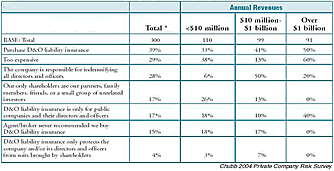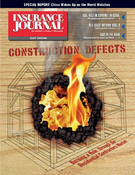The Enron, Adelphia, Global Crossing and WorldCom corporate governance and fraud scandals of 2001 and 2002 may seem like a distant and terrible memory, but the public received some harsh reminders recently. Former Enron CEO Ken Lay was finally brought up on federal charges of conspiracy to defraud, and Adelphia’s wrongdoers were found guilty. Meanwhile, the telecoms aren’t out of the woods yet, as equipment-maker Nortel’s board of directors recently fired CEO Frank Dunn after it discovered that the company’s record profits in 2002 were illusory.
The big names are certainly fodder for Securities and Exchange Commission investigators, federal prosecutors, class-action lawyers and underwriters of directors and officers insurance (D&O). The risks, however, aren’t limited to Fortune 500 companies, to biotechs, high-techs and the telecoms, or even public companies. There are still about 200 to 225 class-action securities fraud cases a year, according to Evan Rosenberg, senior vice president of Chubb Specialty. While that’s down from the 2001 high of 489, the severity of the claims related to these cases is still largely unknown. There are seven $1 billion-plus claims still pending.
Moreover, some speculate that the breakup of a leading class-action litigation firm into two will double the trouble for public companies regardless of size, while institutional investors such as state pension plans are more willing to participate in class-action litigation. Furthermore, the actual impact of the Sarbanes-Oxley corporate governance legislation is still unclear. Some say it won’t have a lasting effect on corporate wrongdoing and will serve as a readymade instrument for class-action lawyers to extract higher and more frequent settlements.
According to the National Union Fire Insurance Co.—the division of American International Group which writes D&O—in 25 recent federal securities class actions, 17 of the companies had revenues of $500 million or less while six had $100 million or less in revenues. And of the 1,850 companies sued in securities class actions, only 100 were Fortune 500 firms, meaning the rest were not.
Peter Taffae, managing director of the Los Angeles-based brokerage Executive Perils Inc., cites the breakup of the Milberg Weiss Bershad Hynes & Lerach securities class-action law firm into two entities (Milberg Weiss Bershad & Schulman and Lerach Coughlin Storia & Robbins) as a major warning sign that no one is really safe. The competition between the firms for business will be fierce, Taffae predicts, and these new firms need to build up a track record of successful settlements in order to attract the large state pension funds as clients.
“You’ll see a great increase in hit-and-run cases,” Taffae told Insurance Journal. “They’ll look for companies with good cash positions, and go for $10 to $25 million settlements.” The company makes cosmetic governance changes in return for a no-sue agreement for three years.
Chubb’s Rosenberg said it’s unlikely that these firms will go after smaller companies, which “just aren’t big enough to hit home runs.” However, smaller companies are vulnerable thanks to the auditing and independence requirements of the Sarbanes-Oxley Act.
“Sarbanes-Oxley has created this whole new way that they can just go after companies for noncompliance,” Rosenberg said. “Our experience tells us that compliance on the smaller end of the spectrum is clearly much more burdensome simply because they don’t have the resources. Some of the small companies are making choices about whether to be in compliance to the absolute letter simply because they can’t do it. It could mean the difference between being in full compliance and making a profit.”
According to the Huron Consulting Group, more than half of all restatements between 1997 and 2001 were by companies with under $100 million in revenues. Brian Inselberg, middle-market president for National Union, said that small public companies may be just as vulnerable as the big fish.
“Public companies are still public companies,” he said. “When you’re dealing with public companies certainly the Fortune 500 companies get a lot of press. But we see the smaller companies going through the process just like a larger company does, except they don’t have as much money to be compliant. … They could be even more of a target.”
On the private company side, standards have been raised across the board as a kind of byproduct of Sarbanes-Oxley, according to Rob Schueler, product manager for management liability at Travelers Bond (as part of the new St. Paul Travelers).
“The principles of Sarbanes are starting to trickle into accounting standards,” he said. “The standards expected by credit companies, for example, are much higher. That’s a growing exposure that board members are taking. And certainly, investors who are not represented on the board themselves have heightened those expectations. Given the growth in that number of nonboard member investors, there also grows the need for appropriate disclosure to outside investors.
“If the outside investor has a reasonable expectation that representations are accurate, it’s more likely to give rise to a suit,” Schueler added. “The bar has been raised for all companies to improve disclosures and reduce their exposures.” A survey of 300 private-company CEOs conducted for Chubb showed that 32 percent reported Sarbanes-Oxley as having a “direct” or “spillover” effect on operations.
Taffae points out that Congressional legislation can often have unintended consequences. The Private Securities Litigation Reform Act, passed in 1995, was supposed to reduce class-action securities litigation but actually increased it. In the four years before the legislation’s passage, there were an average of 190 suits filed each year. Through 2002, an average of 242 suits were filed each year since the reform went into effect. The same, he argues, could happen with Sarbanes-Oxley.
“It’s a disaster,” he said. “The problem with this legislation quite frankly is that the plaintiffs’ bar is so strong that they will not let anything get passed that could put them out of business. They are so smart and shrewd that they manipulate the legislation. This was put through both houses of Congress like a speeding bullet. It was an overreaction to the corporate governance scandals.”
National Union’s Rosenberg said the law “will make companies better for a short period of time, but after a couple of years attention will start to wane. Human beings will slip back to being human beings and do stupid things.” And, he said, the Act’s record-retention requirement will be a goldmine for plaintiffs’ lawyers in discovery, “so once you get into a case, it’ll make things worse.”
In addition to new exposures that may have been inadvertently created by the Act, underwriters and brokers cite a number of traditional exposures such as suits by vendors, customers, employees and the government. According to the Chubb survey, 18 percent reported that their directors and officers had been sued by a customer during the past few years. Seven percent were sued by a vendor, 6 percent by an investor or other shareholder, and 4 percent by a government or regulatory agency.
Meanwhile, a good third of the respondents feared lawsuits in each category. Still, only 39 percent reported having bought D&O—which protects directors and officers’ personal assets in the case of a lawsuit—while nearly 29 percent said it was too expensive (see chart on page N2). Chubb said it thought the 39 percent figure was actually too high, as some respondents probably thought their D&O was included in their general liability or other policy.
Nowadays, however, any company that includes company stock as part of its pension plan is forced to buy D&O as part of a package with fiduciary liability under combined limits, according to Gary Phillips, managing partner of executive liability advisors for the Palmer & Cay brokerage in New York City.
Eric Shapiro, specialty lines assistant vice president for the Southeast region of CNA, explained the trend.
“With the recent precedent-setting cases in D&O, D&O and fiduciary liability have been tied closer together,” he said. “Enron is the shining example where most of the assets of the pension plan were in Enron stock, so when the stock dropped so did the assets of the pension plan. The market has responded there by linking D&O and fiduciary liability together and not providing separate limits of liability. Now for the most part they’re being combined.”
Shapiro added that most private companies still “don’t see as great a need for D&O coverage and are buying it in conjunction with [employment practices liability insurance, or EPLI]. EPLI is really more the driver on the privately held side. … D&O coverage does not exclude EPLI, which really grew out of D&O. The claim has to be brought against a director or an officer.”
Richard G. Clarke, a senior vice president at the Atlanta brokerage J. Smith, Lanier & Co., a RiskProNet agency, said he’s seeing plenty of markets tie together different forms of executive liability with D&O only a minor worry.
“Some underwriters would almost agree that what you’re doing when you’re writing a private company D&O package is that you’re charging the bulk of the package for EPLI and fiduciary claims, and the D&O part is relatively inexpensive.”
As for pricing, a 2003 Tillinghast survey showed that pricing was already easing by the end of last year, though prices were up an average 33 percent for the year. But for the executive liability package available to many middle-market customers, insurer appetite is high and the pricing very competitive.
“We think the small public and private sector is a great area of business,” Chubb’s Rosenberg said. “Our data tells us that this is where we can make some money.”
Topics Lawsuits Legislation Commercial Lines Business Insurance Chubb
Was this article valuable?
Here are more articles you may enjoy.



 Allstate, Nationwide Post Dramatic Q12024 Homeowners Loss Ratio Drops: S&P
Allstate, Nationwide Post Dramatic Q12024 Homeowners Loss Ratio Drops: S&P  Home Insurance at $10,000 a Year Shows California Buyers’ Pain
Home Insurance at $10,000 a Year Shows California Buyers’ Pain  Farmers Adjusters Cry Foul Over Workloads, Claims Handling in Letter to Regulators
Farmers Adjusters Cry Foul Over Workloads, Claims Handling in Letter to Regulators  US P/C Insurers Post Best Q1 Underwriting Result In 17 Years
US P/C Insurers Post Best Q1 Underwriting Result In 17 Years 


